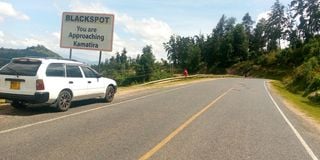Kamatira black spot: Why road users, residents want stretch redesigned

The Kamatira blackspot along the Kitale- Lodwar highway in West Pokot County.
What you need to know:
- The highway links the country to South Sudan, Ethiopia, and countries to the south of Kenya
- The three-kilometre deadly Kamatira is steep and is adjacent to a valley
- Efforts by the government to curb fatal crashes on the notorious stretch have yielded no results
- The deadliest accident happened in 2000 when 60 soldiers died at the spot after their lorry veered off the road and plunged into a ditch
For many travellers on the Kitale- Lodwar highway, the name Kamatira always sends a chill down their spine.
The heart beats faster as one approaches the sign board labeled, “Slow down, Kamatira hotspot", a deadly section of the road that has claimed many lives.
Five sharp corners define the road, often characterised by dark patches of spilled motor oil, shards of broken glass, and mangled remains of vehicle parts littering sections of the road.
Harrowing reports of countless deaths and dozens of victims maimed in accidents on the stretch cause many motorists and travellers journeying along the highway to be in a state of panic.
There has been an upsurge in accidents on the Kamatira stretch. Sadly, no action has been taken.
Key road
The highway links the country to South Sudan, Ethiopia, and countries to the south of Kenya, supplying goods from overseas to the landlocked countries through the port of Mombasa.
The three-kilometre deadly Kamatira is steep and is adjacent to a valley.
According to locals, the black spot that was built during the colonial era and has killed more than 2,000 people, was wrongly designed.
Efforts by the government to curb fatal crashes on the notorious stretch have yielded no results.
The deadliest accident happened in 2000 when 60 soldiers died at the spot after their lorry veered off the road and plunged into a ditch. Two years later, more than 20 people died at there while heading to Lodwar.
More lives have been claimed in accidents at the spot over the years.
It is the reason West Pokot County residents and motorists have called on the national government to redesign the road at Kamatira.
Demos
Three years ago, residents of the region held demonstrations and blocked the road, demanding that the government redesigns it. This forced the Ministry of Public Works to step in and erect road signs, warning drivers to be careful while using the road.
However, lights that were erected to provide more visibility to motorists at night have since been destroyed or they are not working.
Residents now want the road closed and for the government to reopen the old road that was used before this one was built.
“I lost my son on this road and I humbly urge the government to redesign the road,” says Elizabeth Lorema.
Kamatira Chief Stephen Lokato says many accidents have occurred since the road was built and asked the government to intervene and save lives.
“This road is not good for new drivers to the region who are not conversant with it. We are asking the government to redesign this road and save the lives of Kenyans who use this road daily,” he says.
Heavy loads
Lokato says the road cannot accommodate heavy loads. “Many people have lost their lives and we urge the government to intervene,” he says.
Truck drivers and motorists descending the steep slope from Safari Hotel towards Kamatira are accused of engaging the neutral gear on their vehicles and they end up losing control of them as they approach the interchange, leading to nasty accidents.
A driver, Fred Odhiambo, says motorists on the road are getting rough because of constant breakdowns of their vehicles due to it numerous potholes.
“We repair vehicles after almost every trip to or from Lodwar due to the impact of vehicles hitting potholes,” he says.
West Pokot Sub County Police commandant Kipkoech Kirui says the area has been marked as a black spot, and asked drivers to be careful.
“Since January 2022, more than five fatal accidents have occurred at the spot. Drivers who are using the road for the first time should be extra careful,” he says.
Careles
He blames most of the accidents on speeding, careless overtaking, and motorists engaging neutral gear, especially truck drivers.
“The stretch poses a great risk for motorists, cyclists, and pedestrians. Speeding and careless overtaking are predominantly the cause of the series of accidents in the area, orchestrated mostly by trucks ferrying goods and public service vehicles,” states Kirui.
County leaders have also decried the high number of road accidents at the blackspot that have claimed many lives.
Former Nominated member of the County Assembly and businesswoman Teresa Lokichu points out that Kamatira is perhaps the most notorious black spot in the region, given the number of accidents that have happened at the spot.
“We have retrieved many bodies and rushed many seriously injured people to hospital,” she says.
She called for the speedy reconstruction of the highway, saying it will boost trade and lure investors to the region.
Stand accused
West Pokot Governor Simon Kachapin accuses former regimes of failing to redesign the road, despite the government allocating money for its rehabilitation.
“The government should come and work on the road. Why should people die due to bad roads yet they pay taxes?” he asks.
It has been hard for businesses in the area to expand because many people fear going to the area, he says.
“There is a need to redesign the road so that residents and investors can engage in business without any fear,” says Kachapin.
The governor pointed out that revenue collection has been affected due to the deplorable state of the highway.
“Our county is endowed with mineral resources such as limestone, among others. But potential investors are shying away due to the bad condition of the highway,” he says.
Markets within the county are not growing due to loss of trade as a result of the pathetic state of the highway that links products from the county to markets elsewhere.
“They should fast-track construction to avoid further loss of business,” he says.





